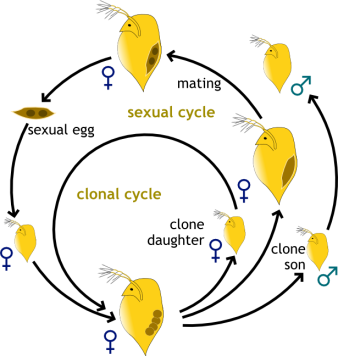Asexual and sexual reproduction are two ways that plants and animals can reproduce, and there are advantages and disadvantages to each of these methods of reproduction. Scientists have harnessed the asexual reproduction habits of a tiny freshwater crustacean in order to better understand the biological effects of environmental pollutants. Before we get to that, let’s talk about reproduction some more.
Less complex organisms generally (bacteria, single celled organisms, plants) reproduce asexually, while more complex organisms (higher invertebrates, fish, mammals, and other vertebrates) reproduce sexually. Asexual reproduction can involve the production of clonal young, and it is beneficial in stable environments. Organism populations that reproduce asexually tend to grow exponentially in number, but the lack of genetic variation in asexual organisms can compromise their ability to adapt to a changing environment over time. In contrast, sexual reproduction can introduce higher levels of genetic variation in offspring, and genetic variation is the fundamental component of evolution.

If there is one thing the history of evolution has taught us it’s that life will not be contained. Life breaks free, it expands to new territories and crashes through barriers, painfully, maybe even dangerously… I’m simply saying that life, finds a way.
-Dr. Ian Malcolm, Jurassic Park (1991)
Much like frogs – whose DNA was used to complete the genetic code of dinosaurs in Jurassic Park – some organisms have evolved unique reproductive strategies to allow them to survive in less than ideal environmental conditions. While frogs from Jurassic Park were able to switch sexes in a one-sex environment, other organisms have evolved the ability to switch from asexual reproduction to sexual reproduction when environmental conditions no longer support population growth. Some examples of these organisms include aphids, starfish, the komodo dragon, and the freshwater crustacean known as the water flea – or the Daphnia.

Daphnia are a particularly interesting case, as the ease with which they can be kept in the laboratory, in addition to their ability to produce clonal young through asexual reproduction, has made them one of the most widely studied organisms in the field of toxicology. Knowledge of Daphnia life cycle strategies and behaviors is extensive, and James E. Klaunig of the University of Indiana stated that Daphnia have become analogous to the modern day version of the “mineshaft canary.” Just as miners brought canaries into the mine to detect the presence of natural gas, scientists expose Daphnia to a multitude of potentially toxic substances to better understand and predict toxic outcomes. In this way, Daphnia have become an early warning system to detect potentially harmful effects that substances might inflict on humans and the natural environment.

The conventional use of Daphnia as a “canary in the coal mine” to detect toxic substances has expanded over the last decade, as scientists have begun to use Daphnia in a new scientific field called environmental genomics. Environmental genomics investigates how genes and environmental stressors interact to evaluate the mechanism of toxicity of a substance, and this can help to more accurately assess risks associated with pollution.
Daphnia are useful tools in the environmental genomics toolbox because when they are in asexual reproductive phases, they produce genetic clones of themselves. Daphnid populations that reproduce clonally are all female. An adult female daphnid produces female babies that are genetically identical to herself, and those babies produce exact clones of themselves, and so on and so forth (see clonal reproductive cycle in Figure 4). In laboratory Daphnia, conditions are controlled so that clonal reproduction is favored. Therefore, the gene expression patterns of laboratory daphnids will only change as a result of controlled environmental stressors or cues.
Daphnia have over 31,000 genes in their genome, and this is much higher than the number of genes in other known genomes. This includes the human genome, which has fewer than 25,000 genes. The daphnia genome is more expansive because it contains more duplicate genes than the human genome.
Even with the difference in genome size, there is still significant overlap in genes between Daphnia and humans. Environmental genomics could be used to link biological processes in Daphnia to similar processes in other organisms (like us humans!). This type of genetic analysis can help scientists shed more light on the mechanism of toxicity of certain pollutants.
For example, a daphnid that is in water containing a pollutant will express its genes in a different way than its clonal sister who is acclimated to water without the pollutant. By using genomics tools, scientists can begin to understand how a substance is toxic to an organism by investigating which genes are turned on or off in pollutant-exposed daphnids compared to unexposed daphnids. Because of clonal reproduction, genetic variation due to sexual reproduction is reduced, and it is easier to tease out effects due to pollutant exposure. So, the fact that scientists can make Daphnia reliably clone themselves means that the genomes of all the generations of a laboratory Daphnia population will be nearly identical. This means that if scientists observe changes in gene expression, it is due to the experimental conditions and not simply random mutation.
While males are not practical for conducting experiments in the laboratory setting, the mere presence of males indicates that Daphnia populations are stressed. Male daphnids are much smaller than their female counterparts, and they have a specialized abdominal appendage that is used for grasping onto females during sex. In the first step of switching to sexual reproduction, the female Daphnia begins to produce clonal sons. She then produces a type of egg that must be fertilized by the males that have now been introduced to the population. Upon fertilization, the egg is dropped from the female. An additional shell layer called the ephippium protects the egg, and the egg can “hibernate” for many months until environmental conditions favor hatching (see sexual cycle in Figure 4). For example, in the case of a drought, the egg would stay in its hibernation phase until the surrounding conditions are wet enough to support daphnid population growth.

Through manipulation of clonal and sexual reproduction, Daphnia have “found a way” to survive overpopulation, lack of food, unpredictable or changing environmental conditions, and exposure to environmental stressors like pollution. The ease with which Daphnia are reared in the lab and their ability to produce exact genetic clones of themselves have made Daphnia an essential component in the field of toxicology and environmental genomics. We are using Daphnia in our laboratories to learn about how nanoparticles are toxic, so that they can be designed in ways that are safer for people and the environment.
As the phrase might go for Daphnia…
“Men. You can live with them, and you can live without them.”
References & Further Reading:
Daphnia Pulex – More Genes Don’t Make You Better But They May Help The Environment
